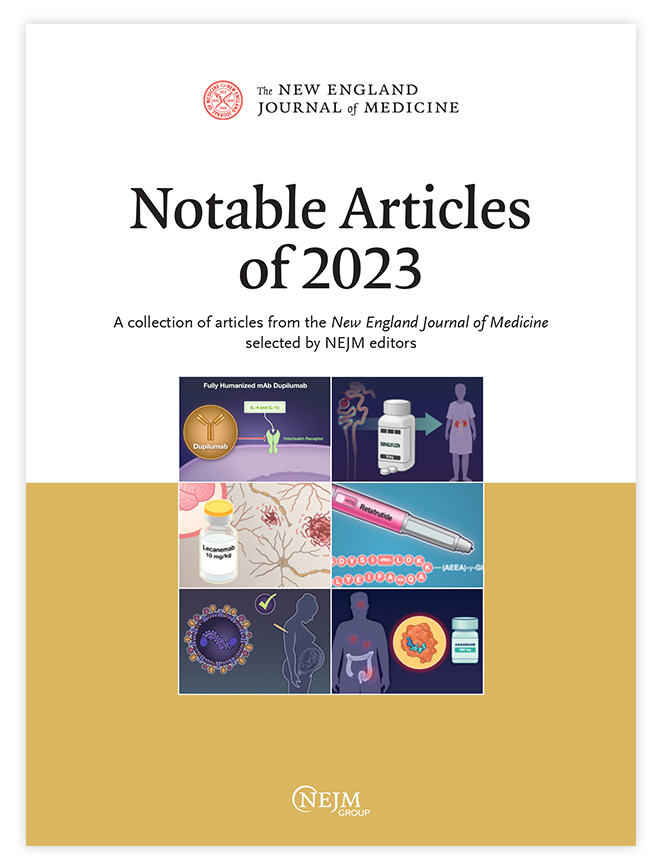Hypertonic Saline or Carbocisteine in Bronchiectasis.
IF 78.5
1区 医学
Q1 MEDICINE, GENERAL & INTERNAL
引用次数: 0
Abstract
BACKGROUND Bronchiectasis guidelines are inconsistent with regard to the effectiveness of mucoactive agents, and their use varies geographically. Large trials are needed to assess safety and effectiveness. METHODS For this open-label, randomized, two-by-two factorial trial at 20 sites in the United Kingdom, we enrolled participants with non-cystic fibrosis bronchiectasis who had frequent pulmonary exacerbations and daily sputum production. Current smokers and persons who had recently received mucoactive treatments were excluded. All participants received standard care and were also assigned either to one of three mucoactive-drug groups - hypertonic saline (the hypertonic-saline group), hypertonic saline and carbocisteine (the combination group), or carbocisteine (the carbocisteine group) - or to standard care alone. The comparisons were between hypertonic saline and no hypertonic saline and between carbocisteine and no carbocisteine, with each category consisting of two groups. The primary outcome was the number of pulmonary exacerbations over a 52-week period. Key secondary outcomes were scores on disease-specific health-related quality-of-life assessments, time to next pulmonary exacerbation, and safety. RESULTS A total of 288 participants underwent randomization. No treatment interactions were found. The mean number of adjudicated fully qualifying pulmonary exacerbations over the 52-week period was 0.76 (95% confidence interval [CI], 0.58 to 0.95) with hypertonic saline as compared with 0.98 (95% CI, 0.78 to 1.19) with no hypertonic saline (adjusted between-group difference in the means, -0.25 [95% CI, -0.57 to 0.07; P = 0.12]) and 0.86 (95% CI, 0.66 to 1.06) with carbocisteine as compared with 0.90 (95% CI, 0.70 to 1.09) with no carbocisteine (adjusted between-group difference in the means, -0.04 [95% CI, -0.36 to 0.28; P = 0.81]). Secondary outcomes and the incidence of adverse events, including serious adverse events, were similar across the groups. CONCLUSIONS In participants with bronchiectasis, neither hypertonic saline nor carbocisteine significantly reduced the mean incidence of pulmonary exacerbations over a period of 52 weeks. (Funded by the National Institute for Health and Care Research Health Technology Assessment Programme and others; ISRCTN Registry number, ISRCTN89040295.).高渗盐水或卡西汀治疗支气管扩张。
背景:关于黏液活性药物的有效性,支气管扩张指南是不一致的,并且它们的使用在地理上是不同的。需要进行大规模试验来评估安全性和有效性。方法:在英国20个地点进行的这项开放标签、随机、2乘2因子试验中,我们招募了患有频繁肺部恶化和每日产痰的非囊性纤维化支气管扩张的参与者。排除当前吸烟者和最近接受过粘膜活性治疗的人。所有参与者都接受标准治疗,并被分配到三种黏液活性药物组中的一种-高渗盐水(高渗盐水组),高渗盐水和卡西汀(联合组),或卡西汀(卡西汀组)-或单独标准治疗。高渗盐水组与无高渗盐水组、卡西汀组与无卡西汀组比较,每组分为两组。主要终点是52周期间肺恶化的次数。关键的次要结局是疾病特异性健康相关生活质量评估评分、下一次肺恶化的时间和安全性。结果随机分组288例。未发现治疗相互作用。在52周期间,高渗盐水组确诊的完全符合条件的肺恶化的平均次数为0.76次(95%可信区间[CI], 0.58至0.95),而无高渗盐水组为0.98次(95% CI, 0.78至1.19)(调整后的组间平均值差为-0.25次[95% CI, -0.57至0.07;P = 0.12])和0.86 (95% CI, 0.66至1.06),而不含卡西汀组为0.90 (95% CI, 0.70至1.09)(校正组间均值差异为-0.04 [95% CI, -0.36至0.28;P = 0.81])。次要结局和不良事件(包括严重不良事件)的发生率在两组之间相似。结论:在支气管扩张患者中,高渗盐水和卡西汀在52周内均不能显著降低肺恶化的平均发生率。(由国家卫生和保健研究所卫生技术评估方案和其他机构资助;ISRCTN登记号码,ISRCTN89040295。)
本文章由计算机程序翻译,如有差异,请以英文原文为准。
求助全文
约1分钟内获得全文
求助全文
来源期刊

New England Journal of Medicine
医学-医学:内科
CiteScore
145.40
自引率
0.60%
发文量
1839
审稿时长
1 months
期刊介绍:
The New England Journal of Medicine (NEJM) stands as the foremost medical journal and website worldwide. With an impressive history spanning over two centuries, NEJM boasts a consistent publication of superb, peer-reviewed research and engaging clinical content. Our primary objective revolves around delivering high-caliber information and findings at the juncture of biomedical science and clinical practice. We strive to present this knowledge in formats that are not only comprehensible but also hold practical value, effectively influencing healthcare practices and ultimately enhancing patient outcomes.
 求助内容:
求助内容: 应助结果提醒方式:
应助结果提醒方式:


